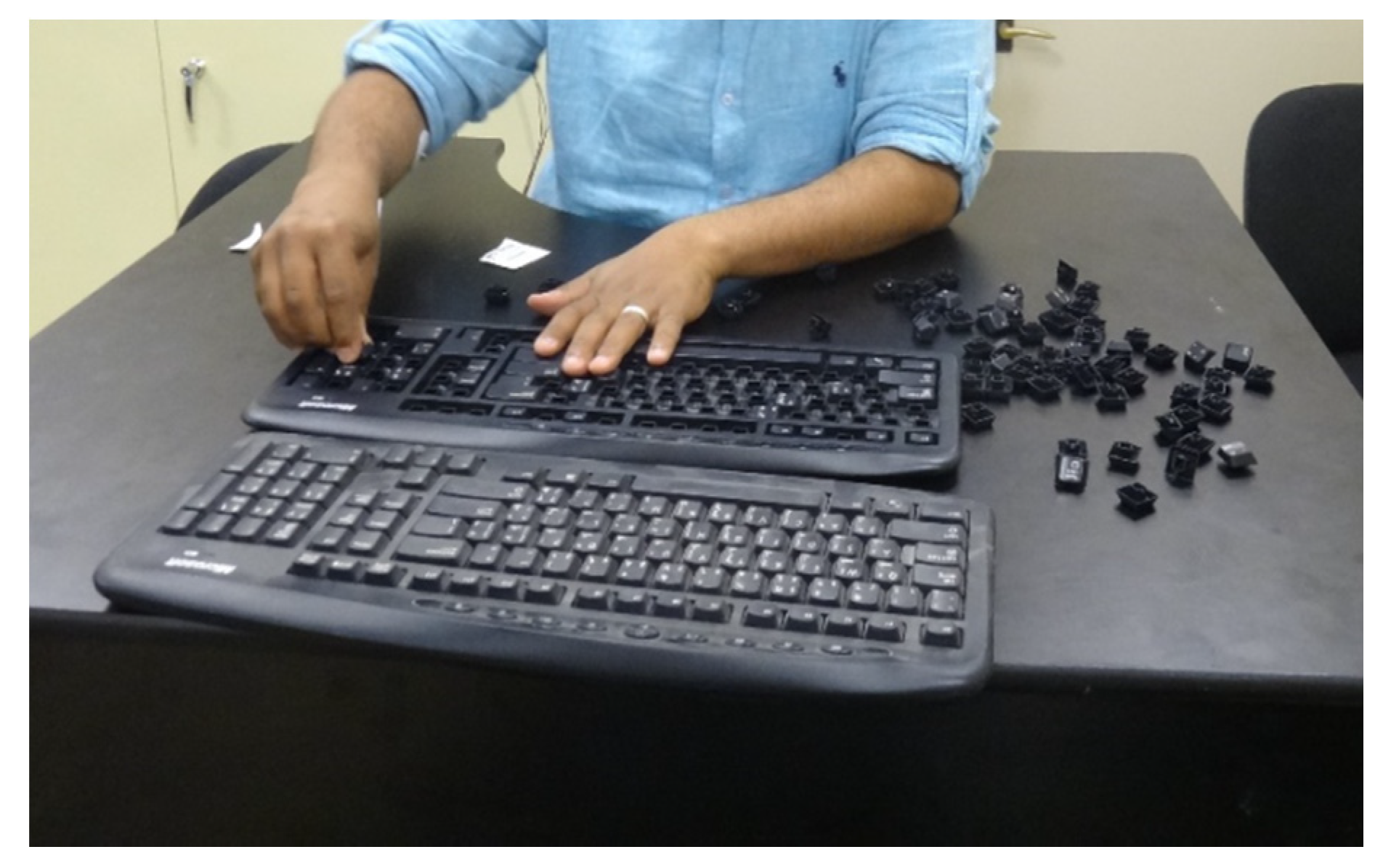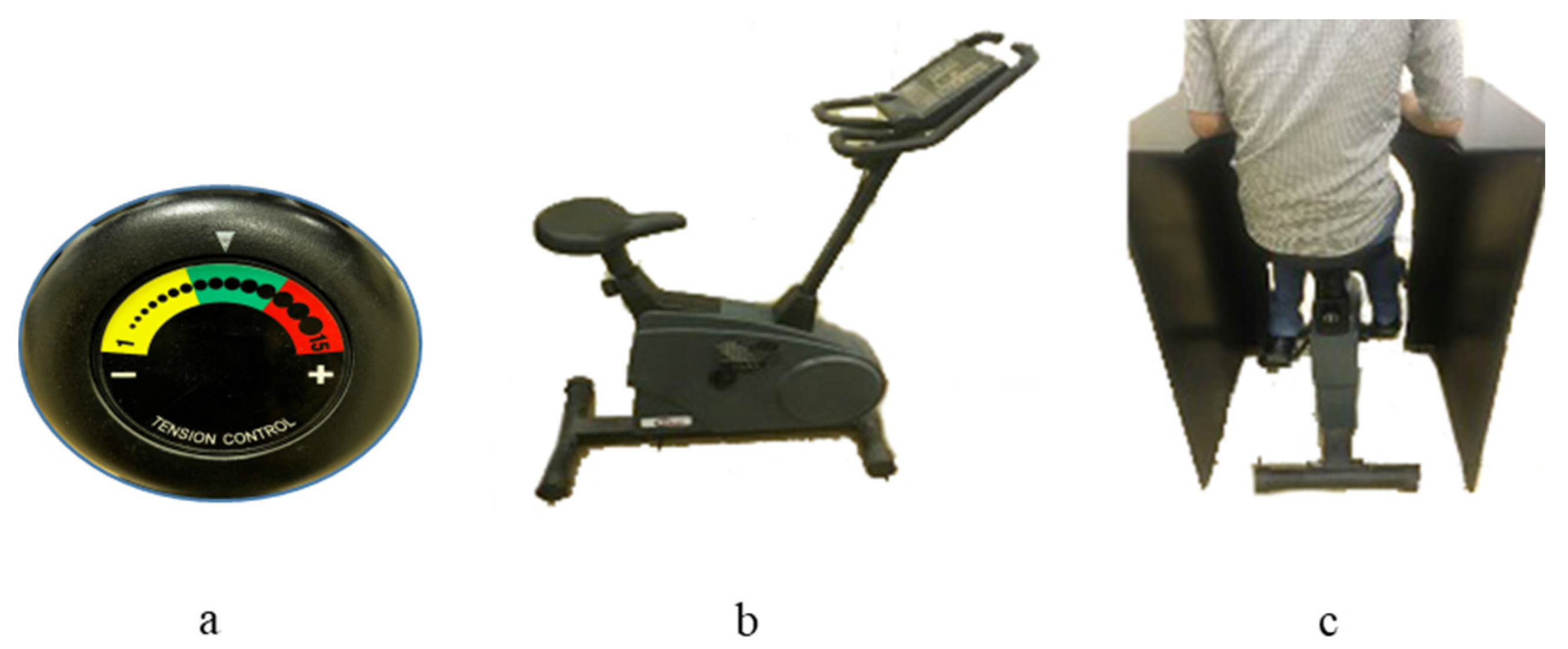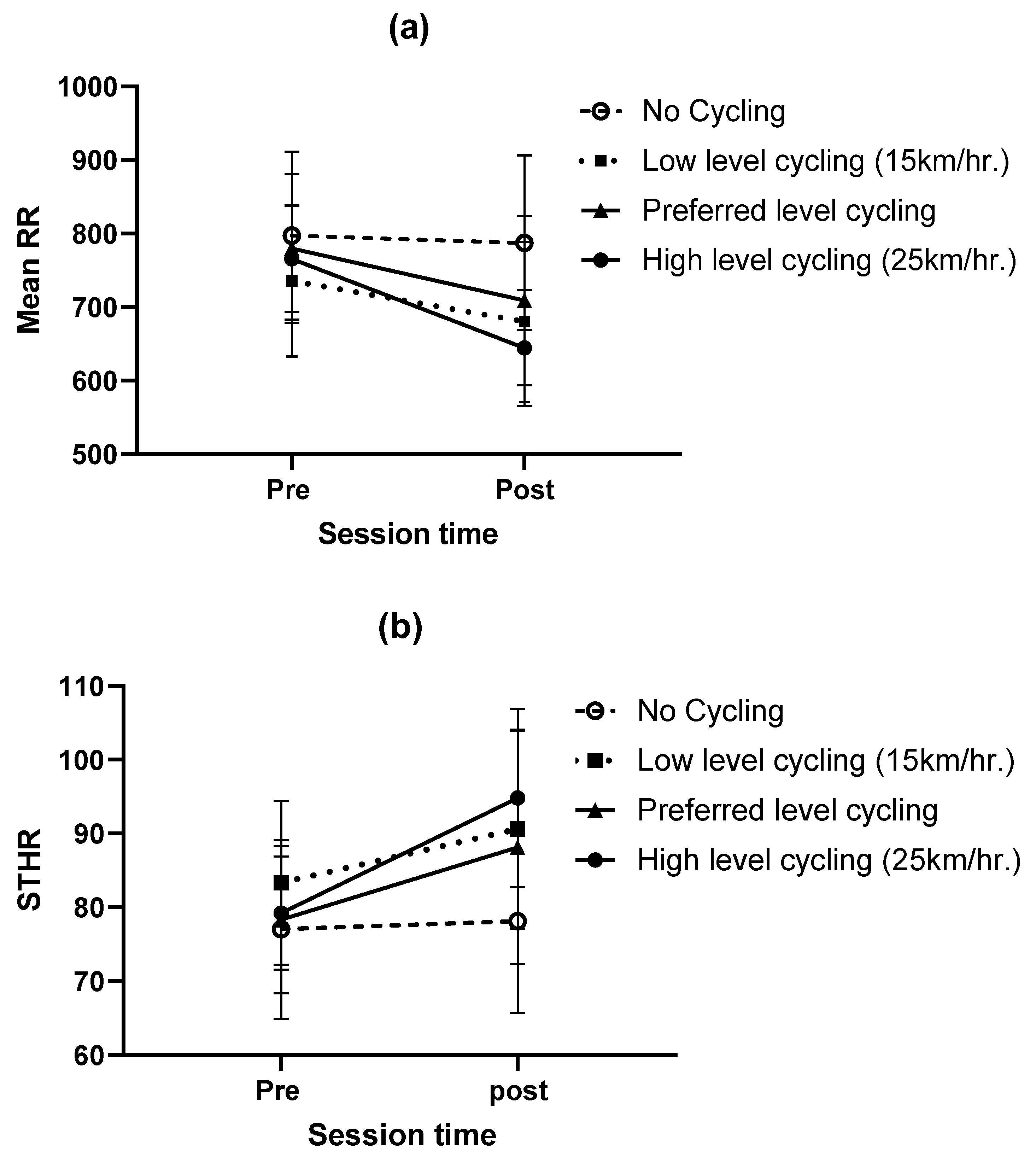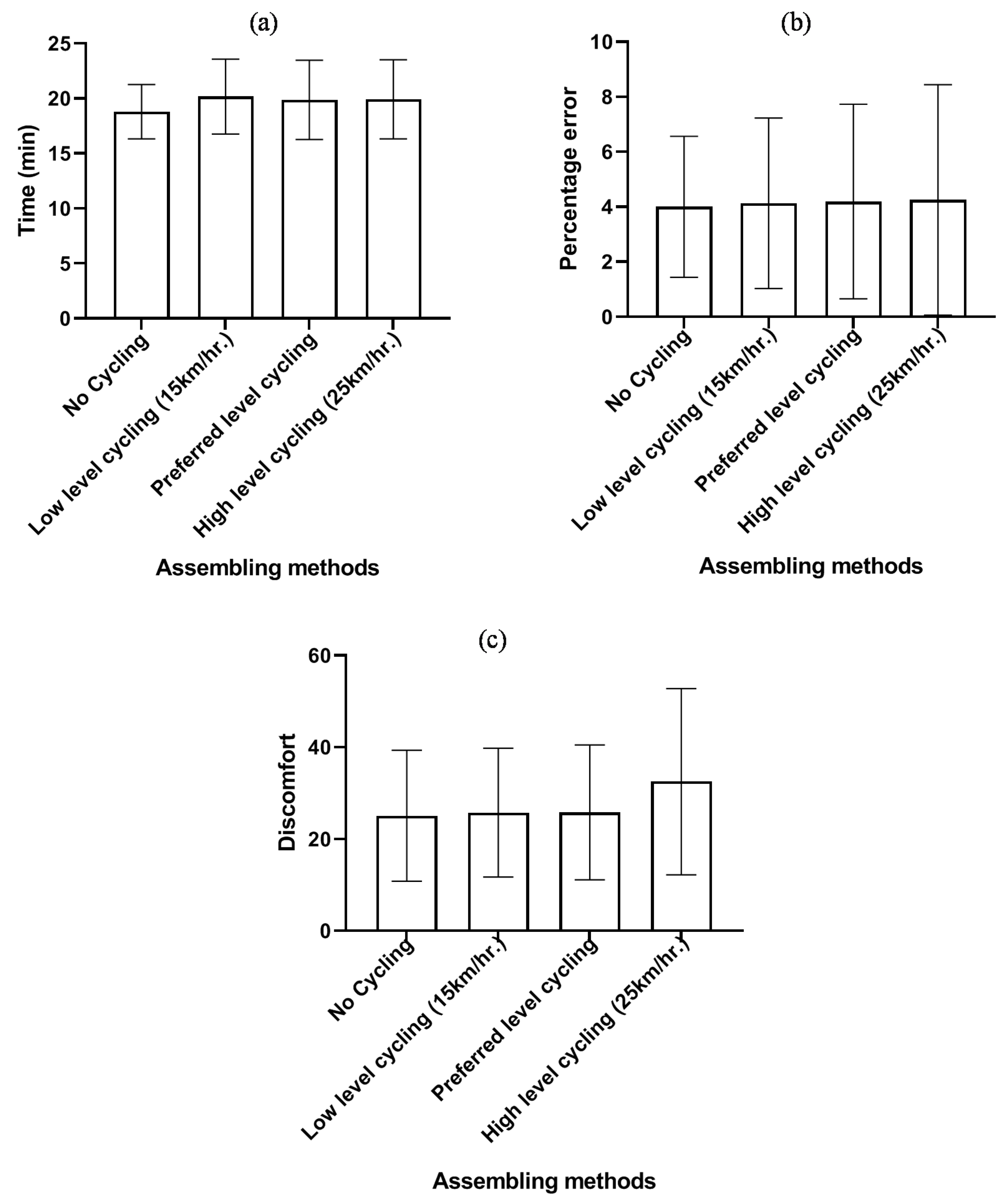Effect of Cycling on a Stationary Bike While Performing Assembly Tasks on Human Physiology and Performance Parameters
Abstract
1. Introduction
2. Materials and Methods
2.1. Study Design
2.2. Participants
2.3. Equipment
2.4. Assembling Task
2.5. Experimental Setup and Procedures
2.6. Response Measures
2.6.1. Electroencephalography (EEG) Signal Responses
2.6.2. Electrocardiographic (ECG) Response Analysis
2.6.3. Performance Measures
2.6.4. Subjective Workload Ratings
2.6.5. Subjective Body Discomfort Ratings
2.7. Experimental Design
2.8. Data Analysis
3. Results
3.1. EEG Signals
3.2. Electrocardiographic (ECG) Response Analysis
3.3. Completion Time, Body Discomfort Rating, and Error Analysis
3.4. Subjective Workload Analysis
4. Discussion
5. Conclusions
Limitations
Author Contributions
Funding
Acknowledgments
Conflicts of Interest
References
- Brownson, R.C.; Boehmer, T.K.; Luke, D.A. Declining rates of physical activity in the United States: What are the contributors? Annu. Rev. Public Health 2005, 26, 421–443. [Google Scholar] [CrossRef] [PubMed]
- Cho, J.; Freivalds, A.; Rovniak, L.S. Utilizing anthropometric data to improve the usability of desk bikes, and influence of desk bikes on reading and typing performance. Appl. Ergon. 2017, 60, 128–135. [Google Scholar] [CrossRef] [PubMed]
- Després, J.-P. Physical activity, sedentary behaviours, and cardiovascular health: When will cardiorespiratory fitness become a vital sign? Can. J. Cardiol. 2016, 32, 505–513. [Google Scholar] [CrossRef] [PubMed]
- Rosique-Esteban, N.; Babio, N.; Díaz-López, A.; Romaguera, D.; Martínez, J.A.; Sanchez, V.M.; Schröder, H.; Estruch, R.; Vidal, J.; Buil-Cosiales, P. Leisure-time physical activity at moderate and high intensity is associated with parameters of body composition, muscle strength and sarcopenia in aged adults with obesity and metabolic syndrome from the PREDIMED-Plus study. Clin. Nutr. 2019, 38, 1324–1331. [Google Scholar] [CrossRef]
- Pate, R.R.; Pratt, M.; Blair, S.N.; Haskell, W.L.; Macera, C.A.; Bouchard, C.; Buchner, D.; Ettinger, W.; Heath, G.W.; King, A.C. Physical activity and public health: A recommendation from the Centers for Disease Control and Prevention and the American College of Sports Medicine. JAMA 1995, 273, 402–407. [Google Scholar] [CrossRef]
- Vandelanotte, C.; Short, C.; Rockloff, M.; Millia, L.D.; Ronan, K.; Happell, B.; Duncan, M.J. How do different occupational factors influence total, occupational, and leisure-time physical activity? J. Phys. Act. Health 2015, 12, 200–207. [Google Scholar] [CrossRef]
- Matthews, C.E.; Keadle, S.K.; Saint-Maurice, P.F.; Moore, S.C.; Willis, E.A.; Sampson, J.N.; Berrigan, D. Use of Time and Energy on Exercise, Prolonged TV Viewing, and Work Days. Am. J. Prev. Med. 2018, 55, e61–e69. [Google Scholar] [CrossRef]
- Tornqvist, E.W.; Hagberg, M.; Hagman, M.; Risberg, E.H.; Toomingas, A. The influence of working conditions and individual factors on the incidence of neck and upper limb symptoms among professional computer users. Int. Arch. Occup. Environ. Health 2009, 82, 689–702. [Google Scholar] [CrossRef]
- Crespo, C.J.; Palmieri, M.R.G.; Perdomo, R.P.; Mcgee, D.L.; Smit, E.; Sempos, C.T.; Sorlie, P.D. The relationship of physical activity and body weight with all-cause mortality: Results from the Puerto Rico Heart Health Program. Ann. Epidemiol. 2002, 12, 543–552. [Google Scholar] [CrossRef]
- Hamilton, M.T.; Hamilton, D.G.; Zderic, T.W. Role of low energy expenditure and sitting in obesity, metabolic syndrome, type 2 diabetes, and cardiovascular disease. Diabetes 2007, 56, 2655–2667. [Google Scholar] [CrossRef]
- Hamilton, M.T.; Healy, G.N.; Dunstan, D.W.; Zderic, T.W.; Owen, N. Too little exercise and too much sitting: Inactivity physiology and the need for new recommendations on sedentary behavior. Curr. Cardiovasc. Risk Rep. 2008, 2, 292–298. [Google Scholar] [CrossRef] [PubMed]
- Healy, G.N.; Wijndaele, K.; Dunstan, D.W.; Shaw, J.E.; Salmon, J.; Zimmet, P.Z.; Owen, N. Objectively measured sedentary time, physical activity, and metabolic risk. Diabetes Care 2008, 31, 369–371. [Google Scholar] [CrossRef] [PubMed]
- Hu, F.B.; Leitzmann, M.F.; Stampfer, M.J.; Colditz, G.A.; Willett, W.C.; Rimm, E.B. Physical activity and television watching in relation to risk for type 2 diabetes mellitus in men. Arch. Intern. Med. 2001, 161, 1542–1548. [Google Scholar] [CrossRef] [PubMed]
- McCrady, S.K.; Levine, J.A. Sedentariness at work: How much do we really sit? Obesity 2009, 17, 2103–2105. [Google Scholar] [CrossRef]
- Van der Ploeg, H.P.; Chey, T.; Korda, R.J.; Banks, E.; Bauman, A. Sitting time and all-cause mortality risk in 222 497 Australian adults. Arch. Intern. Med. 2012, 172, 494–500. [Google Scholar] [CrossRef]
- Warren, T.Y.; Barry, V.; Hooker, S.P.; Sui, X.; Church, T.S.; Blair, S.N. Sedentary behaviors increase risk of cardiovascular disease mortality in men. Med. Sci. Sports Exerc. 2010, 42, 879. [Google Scholar] [CrossRef]
- Levine, J.A.; Miller, J.M. The energy expenditure of using a “walk-and-work” desk for office workers with obesity. Br. J. Sports Med. 2007, 41, 558–561. [Google Scholar] [CrossRef]
- Thompson, W.G.; Foster, R.C.; Eide, D.S.; Levine, J.A. Feasibility of a walking workstation to increase daily walking. Br. J. Sports Med. 2008, 42, 225–228. [Google Scholar] [CrossRef]
- John, D.; Bassett, D.; Thompson, D.; Fairbrother, J.; Baldwin, D. Effect of using a treadmill workstation on performance of simulated office work tasks. J. Phys. Act. Health 2009, 6, 617–624. [Google Scholar] [CrossRef]
- Ohlinger, C.M.; Horn, T.S.; Berg, W.P.; Cox, R.H. The effect of active workstation use on measures of cognition, attention, and motor skill. J. Phys. Act. Health 2011, 8, 119–125. [Google Scholar] [CrossRef]
- Straker, L.; Levine, J.; Campbell, A. The effects of walking and cycling computer workstations on keyboard and mouse performance. Hum. Factors 2009, 51, 831–844. [Google Scholar] [CrossRef] [PubMed]
- Thompson, W.G.; Levine, J.A. Productivity of transcriptionists using a treadmill desk. Work 2011, 40, 473–477. [Google Scholar] [CrossRef] [PubMed]
- Cox, R.H.; Guth, J.; Siekemeyer, L.; Kellems, B.; Brehm, S.B.; Ohlinger, C.M. Metabolic cost and speech quality while using an active workstation. J. Phys. Act. Health 2011, 8, 332–339. [Google Scholar] [CrossRef] [PubMed]
- McAlpine, D.A.; Manohar, C.U.; McCrady, S.K.; Hensrud, D.; Levine, J.A. An office-place stepping device to promote workplace physical activity. Br. J. Sports Med. 2007, 41, 903–907. [Google Scholar] [CrossRef] [PubMed]
- Tomporowski, P.D. Effects of acute bouts of exercise on cognition. Acta Psychol. 2003, 112, 297–324. [Google Scholar] [CrossRef]
- Edwards, J.R.; Cooper, C.L. The impacts of positive psychological states on physical health: A review and theoretical framework. Soc. Sci. Med. 1988, 27, 1447–1459. [Google Scholar] [CrossRef]
- Pronk, N.P.; Martinson, B.; Kessler, R.C.; Beck, A.L.; Simon, G.E.; Wang, P. The association between work performance and physical activity, cardiorespiratory fitness, and obesity. J. Occup. Environ. Med. 2004, 46, 19–25. [Google Scholar] [CrossRef]
- Sallis, J.; Bauman, A.; Pratt, M. Environmental and policy interventions to promote physical activity. Am. J. Prev. Med. 1998, 15, 379–397. [Google Scholar] [CrossRef]
- Edelson, N.; Danoffz, J. Walking on an electric treadmill while performing VDT office work. ACM SIGCHI Bull. 1989, 21, 72–77. [Google Scholar] [CrossRef]
- Gevins, A.S.; Bressler, S.L.; Cutillo, B.A.; Illes, J.; Miller, J.C.; Stern, J.; Jex, H.R. Effects of prolonged mental work on functional brain topography. Electroencephalogr. Clin. Neurophysiol. 1990, 76, 339–350. [Google Scholar] [CrossRef]
- Matousek, M.; Petersén, I. A method for assessing alertness fluctuations from EEG spectra. Electroencephalogr. Clin. Neurophysiol. 1983, 55, 108–113. [Google Scholar] [CrossRef]
- Yamada, F. Frontal midline theta rhythm and eyeblinking activity during a VDT task and a video game: Useful tools for psychophysiology in ergonomics. Ergonomics 1998, 41, 678–688. [Google Scholar] [CrossRef] [PubMed]
- Ramadan, M.Z.; Alhaag, M.H.; Abidi, M.H. Effects of Viewing Displays from Different Distances on Human Visual System. Appl. Sci. 2017, 7, 1153. [Google Scholar] [CrossRef]
- Fairclough, S.H.; Venables, L.; Tattersall, A. The influence of task demand and learning on the psychophysiological response. Int. J. Psychophysiol. 2005, 56, 171–184. [Google Scholar] [CrossRef] [PubMed]
- Slobounov, S.M.; Fukada, K.; Simon, R.; Rearick, M.; Ray, W. Neurophysiological and behavioral indices of time pressure effects on visuomotor task performance. Cogn. Brain Res. 2000, 9, 287–298. [Google Scholar] [CrossRef]
- Zhao, C.; Zhao, M.; Liu, J.; Zheng, C. Electroencephalogram and electrocardiograph assessment of mental fatigue in a driving simulator. Accid. Anal. Prev. 2012, 45, 83–90. [Google Scholar] [CrossRef]
- Jap, B.T.; Lal, S.; Fischer, P.; Bekiaris, E. Using EEG spectral components to assess algorithms for detecting fatigue. Expert Syst. Appl. 2009, 36, 2352–2359. [Google Scholar] [CrossRef]
- Åkerstedt, T.; Gillberg, M. Subjective and objective sleepiness in the active individual. Int. J. Neurosci. 1990, 52, 29–37. [Google Scholar] [CrossRef]
- Torsvall, L.; A kerstedt, T. Sleepiness on the job: Continuously measured EEG changes in train drivers. Electroencephalogr. Clin. Neurophysiol. 1987, 66, 502–511. [Google Scholar] [CrossRef]
- Eoh, H.J.; Chung, M.K.; Kim, S.H. Electroencephalographic study of drowsiness in simulated driving with sleep deprivation. Int. J. Ind. Ergon. 2005, 35, 307–320. [Google Scholar] [CrossRef]
- Lal SK, L.; Craig, A. Driver fatigue: Electroencephalography and psychological assessment. Psychophysiology 2002, 39, 313–321. [Google Scholar] [CrossRef] [PubMed]
- Dishman, R.; Berthoud, H.; Booth, F.; Cotman, C.; Edgerton, V.; Fleshner, M.; Zigmond, M. Neurobiology of Exercise. Obesity 2006, 14, 345–356. [Google Scholar] [CrossRef] [PubMed]
- Van Praag, H. Neurogenesis and exercise: Past and future directions. Neuromolecular Med. 2008, 10, 128–140. [Google Scholar] [CrossRef] [PubMed]
- Van Uffelen, J.G.; Wong, J.; Chau, J.Y.; van der Ploeg, H.P.; Riphagen, I.; Gilson, N.D.; Burton, N.W.; Healy, G.N.; Thorp, A.A.; Clark, B.K. Occupational sitting and health risks: A systematic review. Am. J. Prev. Med. 2010, 39, 379–388. [Google Scholar] [CrossRef]
- Carr, L.J.; Karvinen, K.; Peavler, M.; Smith, R.; Cangelosi, K. Multicomponent intervention to reduce daily sedentary time: A randomised controlled trial. BMJ Open 2013, 3, e003261. [Google Scholar] [CrossRef]
- Hughson, R.L.; Shoemaker, J.K. Autonomic responses to exercise: Deconditioning/inactivity. Auton. Neurosci. 2015, 188, 32–35. [Google Scholar] [CrossRef]
- Owen, N.; Sparling, P.B.; Healy, G.N.; Dunstan, D.W.; Matthews, C.E. Sedentary behavior: Emerging evidence for a new health risk. In Mayo Clinic Proceedings; Elsevier: Amsterdam, The Netherlands, 2010; Volume 85, pp. 1138–1141. [Google Scholar]
- Andreassi, J.L. Psychophysiology: Human Behavior and Physiological Response; Psychology Press: New York, NY, USA, 2010. [Google Scholar]
- Mullen, T.; Kothe, C.; Chi, Y.M. Real-time modeling and 3D visualization of source dynamics and connectivity using wearable EEG. In Proceedings of the Engineering in Medicine and Biology Society (EMBC), 2013 35th Annual International Conference of the IEEE, Osaka, Japan, 3–7 July 2013. [Google Scholar]
- Klimesch, W. EEG alpha and theta oscillations reflect cognitive and memory performance: A review and analysis. Brain Res. Rev. 1999, 29, 169–195. [Google Scholar] [CrossRef]
- Sammer, G.; Blecker, C.; Gebhardt, H.; Bischoff, M.; Stark, R.; Morgen, K.; Vaitl, D. Relationship between regional hemodynamic activity and simultaneously recorded EEG-theta associated with mental arithmetic-induced workload. Hum. Brain Mapp. 2007, 28, 793–803. [Google Scholar] [CrossRef]
- Durka, P.J. From wavelets to adaptive approximations: Time-frequency parametrization of EEG. Biomed. Eng. Online 2003, 2, 1. [Google Scholar] [CrossRef]
- Durka, P.J.; Ircha, D.; Neuper, C.; Pfurtscheller, G. Time-frequency microstructure of event-related electro-encephalogram desynchronisation and synchronisation. Med. Biol. Eng. Comput. 2001, 39, 315–321. [Google Scholar] [CrossRef]
- Niedermeyer, E.; da Silva, F.L. Electroencephalography: Basic Principles, Clinical Applications, and Related Fields; Lippincott Williams & Wilkins: Philadelphia, PA, USA, 2005. [Google Scholar]
- Combatalade, D. Basics of heart rate variability applied to psychophysiology. Signal Process. 2010, 1, 31. [Google Scholar]
- Tarvainen, M.P.; Niskanen, J.-P.; Lipponen, J.A.; Ranta-Aho, P.O.; Karjalainen, P.A. Kubios HRV–heart rate variability analysis software. Comput. Methods Programs Biomed. 2014, 113, 210–220. [Google Scholar] [CrossRef] [PubMed]
- Tarvainen, M.P.; Niskanen, J.-P.; Lipponen, J.; Ranta-Aho, P.; Karjalainen, P. Kubios HRV—A software for advanced heart rate variability analysis. In Proceedings of the 4th European conference of the international federation for medical and biological engineering, Antwerp, Belgium, 23–27 November 2009. [Google Scholar]
- Tarvainen, M.P.; Ranta-Aho, P.O.; Karjalainen, P.A. An advanced detrending method with application to HRV analysis. IEEE Trans. Biomed. Eng. 2002, 49, 172–175. [Google Scholar] [CrossRef] [PubMed]
- Hart, S.G.; Staveland, L.E. Development of NASA-TLX (Task Load Index): Results of Empirical and Theoretical Research, Advances in Psychology; Elsevier: Amsterdam, The Netherlands, 1988. [Google Scholar]
- Vyas, R. Ergonomic assessment of prevalence of musculoskeletal disorders among Indian agricultural workers. J. Ergon. 2014, 4. [Google Scholar] [CrossRef]
- Sharek, D. A Useable, Online NASA-TLX Tool. Available online: https://www.researchgate.net/publication/271716134_A_useable_online_NASA-TLX_tool (accessed on 5 May 2017).
- Berka, C.; Levendowski, D.J.; Lumicao, M.N.; Yau, A.; Davis, G.; Zivkovic, V.T.; Olmstead, R.E.; Tremoulet, P.D.; Craven, P.L. EEG correlates of task engagement and mental workload in vigilance, learning, and memory tasks. Aviat. Space Environ. Med. 2007, 78, B231–B244. [Google Scholar]
- Gevins, A.; Smith, M.E.; Leong, H.; McEvoy, L.; Whitfield, S.; Du, R.; Rush, G. Monitoring working memory load during computer-based tasks with EEG pattern recognition methods. Hum. Factors 1998, 40, 79–91. [Google Scholar] [CrossRef]
- Klimesch, W.; Doppelmayr, M.; Schimke, H.; Ripper, B. Theta synchronization and alpha desynchronization in a memory task. Psychophysiology 1997, 34, 169–176. [Google Scholar] [CrossRef]
- Smith, M.E.; McEvoy, L.K.; Gevins, A. The impact of moderate sleep loss on neurophysiologic signals during working-memory task performance. Sleep 2002, 25, 56–66. [Google Scholar] [CrossRef]
- Elmer, S.J.; Martin, J.C. A cycling workstation to facilitate physical activity in office settings. Appl. Ergon. 2014, 45, 1240–1246. [Google Scholar] [CrossRef]
- Neuhaus, M.; Eakin, E.G.; Straker, L.; Owen, N.; Dunstan, D.W.; Reid, N.; Healy, G.N. Reducing occupational sedentary time: A systematic review and meta-analysis of evidence on activity-permissive workstations. Obes. Rev. 2014, 15, 822–838. [Google Scholar] [CrossRef]
- Tudor-Locke, C.; Schuna, J.; Frensham, L.; Proenca, M. Changing the way we work: Elevating energy expenditure with workstation alternatives. Int. J. Obes. 2014, 38, 755–765. [Google Scholar] [CrossRef] [PubMed]
- Funk, R.E.; Taylor, M.L.; Creekmur, C.C.; Ohlinger, C.M.; Cox, R.H.; Berg, W.P. Effect of walking speed on typing performance using an active workstation. Percept. Mot. Skills 2012, 115, 309–318. [Google Scholar] [CrossRef] [PubMed]
- Koepp, G.A.; Manohar, C.U.; McCrady-Spitzer, S.K.; Ben-Ner, A.; Hamann, D.J.; Runge, C.F.; Levine, J.A. Treadmill desks: A 1-year prospective trial. Obesity 2013, 21, 705–711. [Google Scholar] [CrossRef] [PubMed]
- Beers, E.A.; Roemmich, J.N.; Epstein, L.H.; Horvath, P.J. Increasing passive energy expenditure during clerical work. Eur. J. Appl. Physiol. 2008, 103, 353–360. [Google Scholar] [CrossRef]





| Indices | Assembling Methods | Mean (SD) | b | |
|---|---|---|---|---|
| η2 | p-Value | |||
| Time | No Cycling | 18.8 (2.5) | 0.387 | 0.09 |
| Low level cycling (15 km/h) | 20.2 (3.4) | |||
| Preferred level cycling | 19.9 (3.6) | |||
| High level cycling (25 km/h) | 19.9 (3.6) | |||
| Error | No Cycling | 4.0 (2.6) | 0.005 | 0.99 |
| Low level cycling (15 km/h) | 4.1 (3.1) | |||
| Preferred level cycling | 4.2 (3.5) | |||
| High level cycling (25 km/h) | 4.3 (4.2) | |||
| Discomfort | No Cycling | 25.1 (14.3) | 0.199 | 0.39 |
| Low level cycling (15 km/h) | 25.8 (14.1) | |||
| Preferred level cycling | 25.8 (14.7) | |||
| High level cycling (25 km/h) | 32.5 (20.3) | |||
| Indices | Assembling Methods | Mean (SD) | b | |
|---|---|---|---|---|
| η2 | p-Value | |||
| NASA_Average | No Cycling | 35.1 (12.7) | 0.577 | 0.009 |
| Low level cycling (15 km/h) | 40.1 (14.1) | |||
| Preferred level cycling | 46.4 (11.8) | |||
| High level cycling (25 km/h) | 48.9 (12.2) | |||
| Scale_Mental | No Cycling | 57.6 (24.5) | 0.141 | 0.56 |
| Low level cycling (15 km/h) | 53.7 (24.5) | |||
| Preferred level cycling | 63.5 (22.8) | |||
| High level cycling (25 km/h) | 59.1 (22.1) | |||
| Scale_Physical | No Cycling | 28.4 (16.7) | 0.747 | 0.00 |
| Low level cycling (15 km/h) | 46.7 (22.6) | |||
| Preferred level cycling | 54.3 (21.1) | |||
| High level cycling (25 km/h) | 65.1 (18.0) | |||
| Scale_Temporal | No Cycling | 48.7 (14.9) | 0.170 | 0.47 |
| Low level cycling (15 km/h) | 49.8 (13.4) | |||
| Preferred level cycling | 50.4 (15.2) | |||
| High level cycling (25 km/h) | 53.3 (13.8) | |||
| Scale_Performance | No Cycling | 24.8 (19.1) | 0.086 | 0.25 |
| Low level cycling (15 km/h) | 27.4 (19.0) | |||
| Preferred level cycling | 32.6 (14.4) | |||
| High level cycling (25 km/h) | 24.1 (11.8) | |||
| Scale_effort | No Cycling | 33.8 (22.0) | 0.466 | 0.002 |
| Low level cycling (15 km/h) | 42.9 (24.5) | |||
| Preferred level cycling | 46.6 (24.6) | |||
| High level cycling (25 km/h) | 64.6 (19.8) | |||
| Scale_Frustration | No Cycling | 20.4 (21.9) | 0.008 | 0.72 |
| Low level cycling (15 km/h) | 24.1 (24.9) | |||
| Preferred level cycling | 26.5 (19.8) | |||
| High level cycling (25 km/h) | 26.9 (19.7) | |||
| Parameters | Mean (SD) | A*B | A | B | |||||||||||
|---|---|---|---|---|---|---|---|---|---|---|---|---|---|---|---|
| Session Time | Pre | Post | η2 | p | η2 | p | η2 | p | |||||||
| Assembly Methods | No Cycling | 15 km/h | Preferred | 25 km/h | No Cycling | 15 km/h | Preferred | 25 km/h | |||||||
| EEG responses | α | 598.8 (524) | 568.4 (409.8) | 619 (416.7) | 628.3 (471) | 760.1 (628.2) | 891.7 (765.9) | 799.9 (399.5) | 773.5 (418.2) | 0.065 | 0.824 | 0.313 | 0.02 | 0.021 | 0.964 |
| θ | 300.1 (127.4) | 314.5 (223) | 406.4 (358) | 255 (90.6) | 289.7 (114.7) | 381.1 (255.5) | 258.3 (62.3) | 643.4 (103.5) | 0.188 | 0.424 | 0.081 | 0.27 | 0.105 | 0.683 | |
| β | 335.2 (152.9) | 300.6 (121.1) | 358.7 (133.4) | 301.2 (111.1) | 450.6 (218.8) | 361.2 (113.4) | 438.6 (211.9) | 482.7 (279.8) | 0.166 | 0.486 | 0.468 | 0.002 | 0.274 | 0.229 | |
| θ/α | 0.77 (0.46) | 0.8 (0.5) | 0.9 (0.8) | 0.7 (0.5) | 0.7 (0.51) | 0.7 (0.6) | 0.5 (0.3) | 0.9 (1.0) | 0.241 | 0.293 | 0.115 | 0.184 | 0.106 | 0.68 | |
| β/α | 0.87 (0.65) | 0.8 (0.5) | 0.8 (0.4) | 0.8 (0.6) | 1.0 (1.1) | 0.8 (0.4) | 0.8 (0.7) | 0.8(0.6) | 0.109 | 0.109 | 0.005 | 0.788 | 0.040 | 0.908 | |
| (α + θ)/β | 2.97 (1.54) | 2.8 (1.7) | 2.8 (1.2) | 2.9 (1.5) | 2.74 (1.4) | 2.6 (1.6) | 2.5 (1.01) | 3.2 (1.2) | 0.084 | 0.757 | 0.030 | 0.509 | 0.154 | 0.521 | |
| Parameters | Mean (SD) | A*B | A | B | |||||||||||
|---|---|---|---|---|---|---|---|---|---|---|---|---|---|---|---|
| Session Time | Pre | Post | η2 | p | η2 | p | η2 | p | |||||||
| Assembly Methods | No Cycling | 15 km/h | Preferred | 25 km/h | No Cycling | 15 km/h | Preferred | 25 km/h | |||||||
| Time Domain Measures | R-R (ms) | 797.1 (114.5) | 735.8 (103.1) | 779.7 (101.3) | 765.7 (72.6) | 787.5 (118.8) | 680 (109) | 708.9 (114.9) | 644.3 (79) | 0.783 | 0.00 | 0.788 | 0.00 | 0.439 | 0.051 |
| SDRR (ms) | 27.5 (12.7) | 28.8 (15) | 28.5 (14.2) | 25.8 (7.4) | 29.4 (15.6) | 28.6 (12.2) | 35.6 (39.8) | 23.1 (11.4) | 0.161 | 0.501 | 0.022 | 0.573 | 0.169 | 0.476 | |
| SDHR | 77 (12.1) | 83.3 (11.1) | 78.3 (10) | 79.2 (7.7) | 78.1 (12.4) | 90.6 (13.5) | 88.1 (15.8) | 94.8 (12.1) | 0.806 | 0.00 | 0.745 | 0.00 | 0.405 | 0.072 | |
| RMSSD (ms) | 24.3 (14.3) | 23.6 (16.5) | 24.9 (17.2) | 19.7 (4.5) | 25.8 (15.2) | 21.9 (12.5) | 32 (53) | 16.9 (14.6) | 0.093 | 0.723 | 0.006 | 0.766 | 0.248 | 0.279 | |
| NN50 | 5.3 (7.8) | 6.8 (10.4) | 6.5 (9.3) | 1.7 (1.7) | 5.9 (7.2) | 5 (7) | 6.3 (9.1) | 3.6 (9.6) | 0.158 | 0.509 | 0.001 | 0.889 | 0.153 | 0.524 | |
| pNN50 (%) | 8.2 (12.9) | 7.9 (13.9) | 9.6 (14.5) | 2.2 (2.2) | 9 (12.1) | 6.6 (10.4) | 8.6 (12.2) | 4.1 (10.1) | 0.161 | 0.499 | 0 | 0.941 | 0.206 | 0.376 | |
| VLF (ms2) | 110.4 (112.5) | 110 (144.5) | 121.5 (181.7) | 101.5 (96.5) | 54.8 (50.8) | 116.1 (176.7) | 124.3 (196.9) | 62.6 (73.2) | 0.165 | 0.489 | 0.069 | 0.309 | 0.114 | 0.653 | |
| Frequency DomainMeasures | LF (ms2) | 378.5 (291.9) | 520.4 (570.3) | 556.2 (587.4) | 378.7 (379.7) | 635.9 (620.9) | 619.8 (578.9) | 686 (512.4) | 345.8 (338.2) | 0.142 | 0.56 | 0.086 | 0.252 | 0.130 | 0.597 |
| HF (ms2) | 335.3 (446.1) | 295.5 (461.2) | 419.2 (773.7) | 152.3 (105.7) | 399.1 (559.7) | 211.5 (263.5) | 415.9 (442.6) | 95.3 (98.1) | 0.282 | 0.216 | 0.005 | 0.788 | 0.369 | 0.102 | |
| LF/HF (ms2) | 3.5 (4.2) | 4.5 (4) | 3.7 (3.7) | 3. 9 (3.7) | 3.7 (4.4) | 7.8 (10.4) | 7.1 (8.7) | 6.6 (5.5) | 0.127 | 0.608 | 0.249 | 0.041 | 0.140 | 0.565 | |
© 2020 by the authors. Licensee MDPI, Basel, Switzerland. This article is an open access article distributed under the terms and conditions of the Creative Commons Attribution (CC BY) license (http://creativecommons.org/licenses/by/4.0/).
Share and Cite
Ghaleb, A.M.; Khalaf, T.M.; Ramadan, M.Z.; Ragab, A.E.; Badwelan, A. Effect of Cycling on a Stationary Bike While Performing Assembly Tasks on Human Physiology and Performance Parameters. Int. J. Environ. Res. Public Health 2020, 17, 1761. https://doi.org/10.3390/ijerph17051761
Ghaleb AM, Khalaf TM, Ramadan MZ, Ragab AE, Badwelan A. Effect of Cycling on a Stationary Bike While Performing Assembly Tasks on Human Physiology and Performance Parameters. International Journal of Environmental Research and Public Health. 2020; 17(5):1761. https://doi.org/10.3390/ijerph17051761
Chicago/Turabian StyleGhaleb, Atef M., Tamer M. Khalaf, Mohamed Z. Ramadan, Adham E. Ragab, and Ahmed Badwelan. 2020. "Effect of Cycling on a Stationary Bike While Performing Assembly Tasks on Human Physiology and Performance Parameters" International Journal of Environmental Research and Public Health 17, no. 5: 1761. https://doi.org/10.3390/ijerph17051761
APA StyleGhaleb, A. M., Khalaf, T. M., Ramadan, M. Z., Ragab, A. E., & Badwelan, A. (2020). Effect of Cycling on a Stationary Bike While Performing Assembly Tasks on Human Physiology and Performance Parameters. International Journal of Environmental Research and Public Health, 17(5), 1761. https://doi.org/10.3390/ijerph17051761








